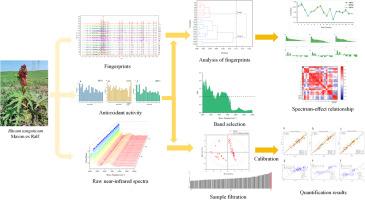大黄抗氧化活性的快速评价:近红外光谱、色谱效应和机器学习的协同策略
IF 8.2
1区 农林科学
Q1 CHEMISTRY, APPLIED
引用次数: 0
摘要
本研究采用HPLC指纹图谱法和近红外光谱法对大黄的抗氧化能力进行评价。HPLC指纹图谱综合表征了其复杂的化学成分,鉴定出13种化合物。同时,近红外光谱提供了快速、无损的方法来预测抗氧化能力。这些技术的结合为评估抗氧化活性提供了一个全面而有效的策略。通过将ABTS、DPPH和FRAP三种抗氧化测定结果与HPLC鉴定的共峰面积相关联,分析了光谱效应关系。糖基化的蒽醌,特别是共轭形式如大黄苷-8- o -葡萄糖苷,被发现与游离苷元协同增强抗氧化活性。使用PLS方法和基于python的算法优化的近红外模型显示出较强的预测能力,ABTS的RPD值为2.43,DPPH为2.63,FRAP为2.43。本研究提供了一种快速评价Rh抗氧化能力的方法。为今后在其他领域的应用提供参考。本文章由计算机程序翻译,如有差异,请以英文原文为准。

Rapid evaluation of antioxidant activity of Rheum tanguticum: A synergistic strategy of near-infrared spectroscopy, chromatographic effects, and machine learning
This study integrates HPLC fingerprinting and NIR spectroscopy to evaluate the antioxidant capacity of Rheum tanguticum. HPLC fingerprinting comprehensively characterized the complex chemical composition, identifying 13 compounds. Meanwhile, NIR spectroscopy provided a rapid, non-destructive approach to predict antioxidant capacity. The combination of these techniques offers a holistic and efficient strategy for evaluating antioxidant activity. The spectrum-effect relationships were analyzed by correlating the results of three antioxidant assays (ABTS, DPPH, and FRAP) with the peak areas of the common peaks identified by HPLC. Glycosylated anthraquinones, particularly conjugated forms like rhein-8-O-glucoside, were found to synergistically enhance antioxidant activity with free aglycones. NIR models optimized using the PLS method with Python-based algorithms demonstrated strong predictive abilities, achieving RPD values of 2.43 for ABTS, 2.63 for DPPH, and 2.43 for FRAP. This research provides a rapid method to evaluate the antioxidant capacity of Rh. tanguticum, offering a reference for future applications in other fields.
求助全文
通过发布文献求助,成功后即可免费获取论文全文。
去求助
来源期刊

Food Chemistry: X
CHEMISTRY, APPLIED-
CiteScore
4.90
自引率
6.60%
发文量
315
审稿时长
55 days
期刊介绍:
Food Chemistry: X, one of three Open Access companion journals to Food Chemistry, follows the same aims, scope, and peer-review process. It focuses on papers advancing food and biochemistry or analytical methods, prioritizing research novelty. Manuscript evaluation considers novelty, scientific rigor, field advancement, and reader interest. Excluded are studies on food molecular sciences or disease cure/prevention. Topics include food component chemistry, bioactives, processing effects, additives, contaminants, and analytical methods. The journal welcome Analytical Papers addressing food microbiology, sensory aspects, and more, emphasizing new methods with robust validation and applicability to diverse foods or regions.
 求助内容:
求助内容: 应助结果提醒方式:
应助结果提醒方式:


